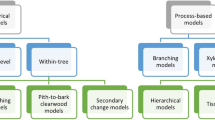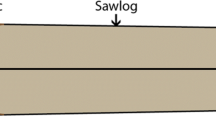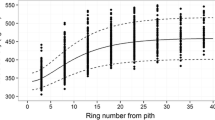Abstract
Taking sessile oak as an example, this paper initially presents a method to predict the final production (quantity and quality) coming from a forest resource when two sets of data are available. The data sets are from two models: measured or simulated ring width profiles from pith to bark of the constituent trees as well as a mixed model for the basic wood properties which are used to grade the boards into quality clusters. The second part of the paper contains a validation for the proposed method. Simulations are used to predict two basic wood properties (volumetric swelling coefficient and wood density) in the trees of a forest resource in relation to the ring width profile of each tree. The simulations are used to compute a map of these two basic properties in each plank derived from the trees. A quality index derived from this map of basic wood properties in the boards is then used to allocate the planks to quality clusters. The basic wood properties considered in this paper are modelled with linear mixed models. Since computation of the plank properties or definition of the grading rule can use several properties simultaneously, the models used to simulate the basic properties are joint models. Modelling jointly several properties with a mixed model consists of defining a covariance structure between the random effects of the model. Such a model can be substantial in terms of parameters and computational resources required, thus we compared three kinds of joint models. The simplest one is not quite a joint model but is simply obtained from the juxtaposition of independent models, one for each of the two properties taken into consideration. We also defined a model with a moderate covariance structure between the two properties, and lastly, we used a third model with a full covariance structure. Simulations of volumetric swelling coefficient, wood density and the resulting board grading were carried out with each of these three models. All give results roughly in accordance with the observations, but the two “truly” joint models give better results than the simplest model.






Similar content being viewed by others
References
AFNOR (1985) Détermination du retrait. Norme AFNOR NF B 51–006
Akaike H (1973) Information theory and an extension of the maximum likelihood principle. In: Czaki F, Petrov BN (eds) Proceedings of international symposium on information theory. Academia Kiado, Budapest, pp 267–281
Constant T, Badia M A, Mothe F (2003) Dimensional stability of douglas fir and mixed beech-poplar plywood: experimental measurements and simulations. Wood Sci Technol 37(1):11-28
Dhôte J-F, Hatsch E, Rittié D (1997) Profil de la tige et géométrie de l’aubier chez le Chêne sessile (Quercus petraea Liebl.). Bulletin technique de l’ONF 33:59–81
Dhôte J-F, Hatsch E, Rittié D (2000) Forme de la tige, tarifs de cubage et ventilation de la production en volume chez le Chêne sessile. Ann Forest Sci 57:121–142
Guilley E (2000) La densité du bois de Chêne sessile (Quercus petraea Liebl.): élaboration d’un modèle pour l’analyse des variabilités intra- et inter-arbre; origine et évaluation non destructive de l’effet “arbre “; interprétation anatomique du modèle proposé. Thèse de l’Ecole Nationale du Génie Rural et des Eaux et Forêts, France, p 206
Guilley E, Hervé J-C, Nepveu G (1996) Simulation of the distribution of technological properties of boards coming from a tree population with inter-tree structuration of variability and covariability. Application to warp of boards in Oak (Quercus petraea Liebl.). In: Proceedings of the second workshop “connection between silviculture and wood quality through modelling approaches and simulation software”. Berg-en-Dal Kruger National Park, South Africa, 26–31 August 1996, pp 113–122
Guilley E, Loubère M, Nepveu G (1999) Identification en forêt de chênes sessiles (Quercus petraea) présentant un angle du fil du bois intrinsèquement faible. Can J For Res 29:1958–1965
Le Moguédec G (2000) Modélisation de propriétés de base du bois et de leur variabilité chez le Chêne sessile (Quercus petraea Liebl.). Simulations en vue de l’évaluation d’une ressource forestière. Thèse de l’Institut National Agronomique Paris-Grignon, Paris, France, p 270
Le Moguédec G, Nepveu G (2000) Simulating distribution of basic properties of wood pieces coming from a tree population: the interest of joint modelling. JABES (in press)
Le Moguédec G, Dhôte J-F, Nepveu G (2000) Choosing simplified mixed models for simulations when data have a complex hierarchical organization. An example with some basic properties in Sessile oak wood (Quercus petraea). Ann Forest Sci 59(8):847–855
Mitchell K J (1988) SYLVER: modelling the impact of silviculture on yield, lumber value, and economic return. Forest Chron 64(2):127–131
Nepveu G, Constant T, Colin F, Dhôte J-F, Guilley E, Le Moguédec G (1999) Along the chain from the plant to the plank: the experience recently gained in Sessile Oak (Quercus petraea Liebl.) by the French connection. In: Proceedings of the third workshop “connection between silviculture and wood quality through modelling approaches and simulation software”. La Londe-Les-Maures, France, 5–12 September 1999, pp 514–525
Saint-André L, Leban J-M, Houllier F (1995) WinEPIFN 1.0: logiciel pour modéliser et simuler la qualité des bois d’une ressource forestière existante. Modèles pour l’Epicéa Commun. Pour PC sous Windows, Equipe de Recherches sur la Qualité des Bois, INRA, 54280 Champenoux, France
SAS Institute (1997) SAS/STAT software: change and enhancements through release 6.12. Cary, NC, p 1162
Seifert T (1999) Modelling wood quality of Norway spruce (Picea abies) depending on silvicultural treatment. In: Proceedings of the third workshop “connection between silviculture and wood quality through modelling approaches and simulation software”, La Londe-Les-Maures, France, 5–12 September 1999, pp 534–540
Author information
Authors and Affiliations
Corresponding author
Appendix: Simulating properties according to a linear mixed model
Appendix: Simulating properties according to a linear mixed model
With matrix notations, a linear mixed model can be written as:
where P ij is the vector of properties for cube j in tree i, X ij and Z ij are respectively the incidence matrixes of the fixed and random effects for cube j in tree i, β is the vector of fixed effects, u i is the vector of random effects for the tree i (that is the “tree effect”), e ij is the vector of residual effects for cube j in tree i.
Matrixes X ij and Z ij are known. They contain the characteristics of the ring width profile (ring width, age from the pith, etc.). Vectors u i and e ij have to be simulated according to centred multidimensional normal laws with variance matrixes G and R respectively.
Vector β and matrixes G and R have been estimated and are here considered as known.
The most technical point in the simulation of the properties is how to simulate a normal random vector v according to a given variance matrix V.
Let w be a p-dimensional random normal centred vector with variance matrix I p , where I p is the (p*p) identity matrix. The p components of such a vector are independent and can be simulated from p independent simulations of a standard normal random variable, one simulation per component.
Let L be any (p*p) matrix. As a classical statistical result, the vector (Lw) is a centred normal random vector with variance matrix LI p L’= LL’, where L’ is the transposition of L.
If the matrix L is chosen so that we have LL’=V, the vector v=Lw has a centred normal distribution with variance matrix V.
Since V is a variance matrix, it is a semi-definite positive matrix. For a given V, in general, several matrixes L exist so that LL’=V. One of the different solutions is to choose L as the Cholesky decomposition of V.
To simulate the basic wood properties, one simulation of u i per tree with the variance matrix G is needed, and one simulation of e ij per cube with the variance matrix R.
Simulation of standard normal law and matrix operations (addition, multiplication, Cholesky decomposition, etc.) are available in most scientific programming languages, either directly or from routine libraries. If all the parameters of the model are known, there is no difficulty in programming simulation of properties according to a linear mixed model.
Rights and permissions
About this article
Cite this article
Le Moguédec, G., Nepveu, G. Using a chain of models to simulate the distribution between quality clusters of a set of boards coming from a sessile oak (Quercus petraea Liebl.) resource. Validation of the simulations. Wood Sci Technol 38, 451–463 (2004). https://doi.org/10.1007/s00226-004-0231-y
Received:
Published:
Issue Date:
DOI: https://doi.org/10.1007/s00226-004-0231-y




